An exclusive look at Binet and Field’s new B2B marketing research
The most effective practices in B2B marketing are mainly the same as in B2C because the two are actually not polar opposites, according to new findings from noted British researchers Les Binet and Peter Field that I have exclusively obtained for The Drum.

Binet and Field are most famous for The Long and The Short of It, a popular 2013 book published by the UK’s Institute of Practitioners in Advertising (IPA) that recommends specific best practices in balancing short- and long-term marketing strategies. The two updated their findings in a presentation at EffWeek in London last year.
LinkedIn commissioned Binet and Field to study the same issues in a B2B context. The two presented their results at a private LinkedIn event in New York City yesterday (22 May). LinkedIn exclusively shared the major findings with me and The Drum in advance of a planned public release later this year. The new research uses Binet and Field’s prior methodology but isolates the B2B case studies in the IPA’s databank.
“Binet and Field’s research has the potential to radically reshape the marketing industry by re-orienting marketers towards brand building strategies,” Peter Weinberg, global lead of market development at LinkedIn Marketing Solutions, said. “Unfortunately, most B2B marketers are unfamiliar with this research, and the research itself does not distinguish between B2C and B2B marketing.”
“We saw an opportunity to popularise Binet and Field’s recommendations among our client base by commissioning a B2B cut of the data. In particular, we’re trying to show our B2B clients that investing in both brand and demand is a more effective strategy than investing solely in lead generation.”
Binet is head of effectiveness at the London communications agency adam&eveDDB. Field is a marketing consultant.
“Peter Field and I spent the last 12-13 years trying to understand how B2C marketing works, and I think we’ve made quite a bit of progress,” Binet said in an interview. “We’ve established that there are some broad principles and rules that you need to follow. But nobody’s ever been sure whether the same rules apply to B2B. We’ve now reached the point where we’ve got sufficient data to begin to do a bit of tentative analysis.”
Binet and Field’s six principles of B2B growth are to build a strong brand, expand the customer base, maximise mental availability, harness the power of emotion, budget for growth and balance the budget between brand building and activation. Just like in B2C.
‘Advertising does work in B2B’
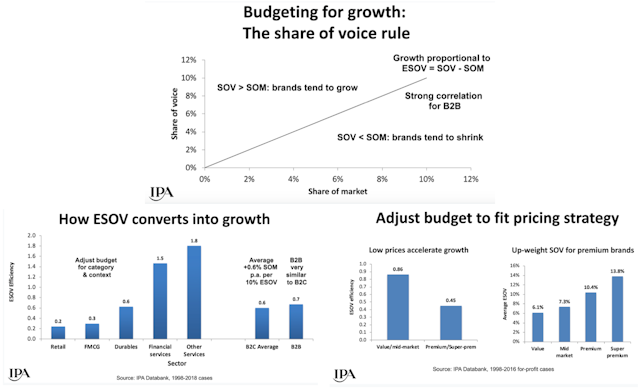
“Advertising does work in B2B,” Binet said. “Share of voice is a relevant metric in B2B. How fast a brand grows to a very large depends on its share of voice and in particular whether its share of voice is above or below its share of market. That rule seems to apply almost exactly to B2B. We can be 95% confident that the share of voice rule applies at all. The rules for budget setting in B2B seem to be pretty much exactly the same as in B2C.”
As I noted in a prior column, excess share of voice (ESOV) is a metric that marketers will also need to keep in mind whenever the next recession hits.
54% sales activation and 46% brand building
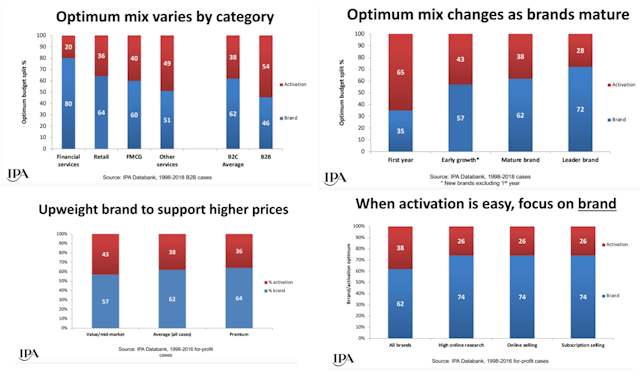
Binet and Field’s prior research advocated a general best practice of allocating, on average, 60% of spend towards long-term brand building and 40% towards short-term activation. (I highlighted that idea in a prior column on how an over-reliance on quick, online direct response hurts many marketing campaigns.)
The most significant difference in Binet and Field’s new B2B research is that, on average, the divide is reversed but a little more equal. Activation – or lead generation, in B2B terminology – should get 54% of spend while brand building should receive 46%.
“B2B is a bit more rational, a bit more activation-heavy,” Binet said.
In the cold war between B2C and B2B marketing, I have seen that the latter group never talks about building brands for long-term success. Rather, those on the B2B side love to discuss ‘performance marketing’ and ‘results-based marketing’. But those are merely new ways to describe sales activation and direct response. According to Binet and Field’s research, the best ‘growth hack’ seems simply to build a strong brand.
Too many B2B marketers care only about what happens immediately in dashboards and spreadsheets and not what changes occur inside people's heads over the long term. But it is our brains that tell us what to buy.
‘Reach is the name of the game in B2B’
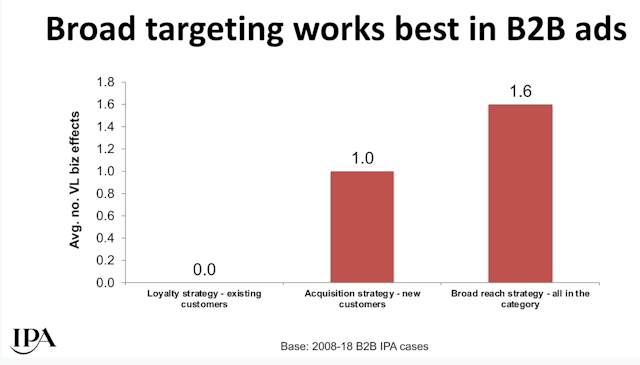
One ongoing debate in the marketing industry is whether it is better to acquire new customers or to get existing customers to spend more. Byron Sharp, for example, argues for the former, and Binet said he agreed with the advocacy of ‘penetration-first strategies’ in the context of both B2C and B2B.
“The data that we’ve got suggests that it’s very similar in B2B,” he said. “We actually don’t have any examples in our limited sample of B2B campaigns that work through increasing brand loyalty. They all seem to work by expanding the customer base, and the campaigns that took a broad reach approach seemed to work best of all. It looks that reach is the name of the game in B2B as well as in B2C.”
Seth Godin recently wrote that “reach is overrated.” He might want to reconsider that statement.
Mental availability is also key

Binet and Field had found earlier that the reason for the 60% average focus on brand building is in part to increase top of mind awareness among all potential category buyers. Then, when a consumer decides to make a purchase, he will be more likely to choose the advertiser’s company. Binet said the same is true in B2B.
Brand building is emotional, activation is rational
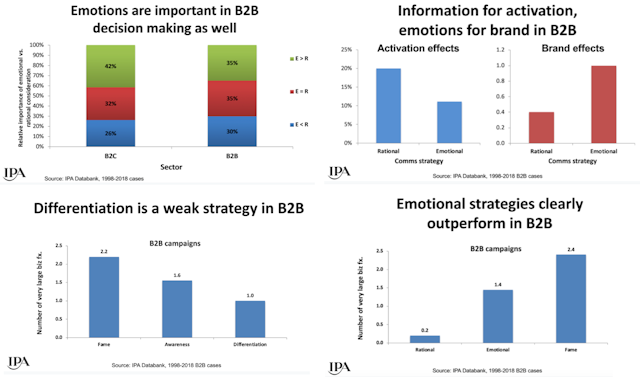
Binet and Field had also found earlier that B2C brand building is emotion-driven while sales activation depends on marcom with statements that appeal to reason.
“In B2B, it seems to work exactly the same way,” Binet said. “Brand building is primarily emotional, activation is primarily rational. You do have to have a slightly more rational approach. Targeting matters a little more.”
Personally, I can only hope that this research will be the final nail in the coffin of the B2B world’s obsession with so-called “content marketing,” which is the production of something rational and informative and then selling something on the side almost as an afterthought. Consumer brands and tech software platforms are not –and should not be – media companies.
After all, HubSpot – the most well-known proponent and user of the practice – has not had an annual profit since at least 2011 and has lost at least $40m every year since 2014. (In 2018, that annual net income loss jumped to almost -$64m.)
And I would love to see creativity return to the B2B world. Forget the taglines and other copy that is just a boring list of product features and uses. I mean, how different is your product from those of your competitors – really?
Another new B2B marketing study
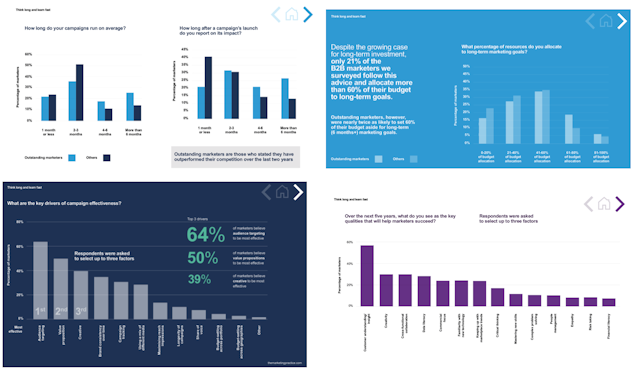
Separately from Binet and Field’s new research, the UK-based marketing agency The Marketing Practice also recently released a similar study on B2B effectiveness inspired by the two’s earlier findings.
“We compared the attitudes of B2B marketers who outperformed their competition over the last two years with their peers,” David van Schaick, the firm’s chief marketing officer, said. “We found that those marketers who outperform their competition think and act long-term, are twice as likely to run and measure campaigns for more than six months, twice as likely to invest more than 60% of their budget towards long-term goals and nearly twice as likely to contract with agencies for two years.”
The report – summarised by van Schaick as “think long and act quick” – also found that the greatest drivers of B2B effectiveness were the targeting, proposition and creative. For the future, the respondents said customer insight, creativity and cross-functional collaboration will be the most important things to have.
B2B and B2C are still a little different
While the best practices in B2B and B2C marketing seem to be similar, the two sides are also facing an identical problem.
“B2B marketing is facing the same battle as B2C – balancing effectiveness and efficiency,” van Schaick said. “There are several reasons why a short-term efficiency focus has taken precedence: the explosion of data, the growth of silos based around channels and a lack of trust from the business.
“Long-term thinking will help improve effectiveness on the macro measures, but it needs to be supported by agile working that makes use of the micro measures – small, multi-disciplinary teams and short feedback cycles. B2B marketers can learn from B2C to adopt this combination of long-term thinking and agile working.”
But van Schaick noted one important difference.
“The longer sales cycles in B2B mean that long-term thinking isn’t just brand building – sales and demand generation also require long-term mindsets,” he said. “The research also suggests leading marketers are more likely to test, learn and adapt rather than cut and run.”
In the end, there is no such thing as ‘traditional marketing’ or ‘online marketing’ – there is only marketing. Based on Binet and Field’s new research, there seems to be little distinction between ‘B2C marketing’ and ‘B2B marketing’ as well.
The Promotion Fix will return on 10 June.
The Promotion Fix is an exclusive biweekly column for The Drum contributed by global keynote marketing speaker Samuel Scott, a former newspaper editor and director of marketing in the high-tech industry. Follow him on Twitter. Scott is based out of Tel Aviv, Israel.

